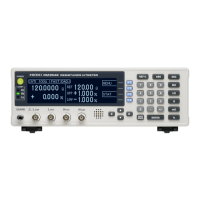2.2 Connecting Measurement Cables and Test Fixtures
24
Recommended Measurement Cable Specifications
Example: JIS standard 3C-2V, 1.5D-2V MIL standard RG-58A/U
* Teflon is a registered trademark of E. I. du Pont de Nemours and Company.
Making Your Own Measurement Cables
Conductor resistance
500 m
/m or less
Capacitance 150 pF/m or less
Cable dielectric material Polyethylene (PE), Teflon* (TFE), polyethylene foam (PEF)
Insulation resistance at least 10 G
Connector insulating material Teflon* (TFE), polybutylene terephtalate (PBT)
Insulation resistance at least 10 G
Length 2 m or less
Before Wiring
• Twist together the H
POT
and L
POT
wires, and the H
CUR
and L
CUR
wires. If not twisted together, mea-
sured values may be unstable and errors occur when measuring with low-power resistance, or low resis-
tance values.
• Refer to the block diagram (p. 14) for internal circuit details.
• Probes and measurement objects should be shielded at BNC or GUARD jack potential.
• Measurement cable length should not exceed 2 m (with conductor resistance 500 m/m or less).
Long cables are more susceptible to noise, and measured values may be unstable.
• Extensions should maintain the four-terminal structure. If converted to a two-terminal circuit in the
wiring, correct measurement may not be possible due to the effects of wiring and contact resis-
tance.
• Cables and measurement objects should be shielded.
• After extending measurement cables, confirm operation and accuracy ("Measurement Specifica-
tions" (p.176)).
• If cutting the ends off of optional measurement cables, make sure that the shield does not touch
the center conductor of the H
CUR
, H
POT
, L
POT
and L
CUR
cables. Correct measurement is not pos-
sible with a shorted cable.
Extending Measurement Cables
Observe the following when extending measurement cables:

